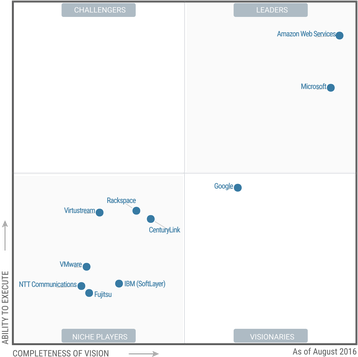Gartner’s August 2016 Magic Quadrant of Cloud Infrastructure as a Service (Iaas) has two players in the leaders’ quadrant, seven players in the niche quadrant and only one visionary. There are no prizes for guessing who the two leaders are and maybe only a small prize for guessing that Google is the visionary. Whilst this particular report is aimed at global providers of IaaS and excludes UK-only IaaS providers, it raises a very interesting question; does the UK-based provider of IaaS have a future?
I believe the short answer is ‘yes’. However, the way domestic providers of IaaS - such as my own employer, Pulsant - go to market is changing and in many respects has changed already. Microsoft has announced a UK data center as has Amazon, so one of the mid-market’s chief differentiators until now, data sovereignty, has disappeared overnight. No longer is the local IaaS provider able to claim that its cloud is located in the UK while the big players are offshore. Why wouldn’t everyone then just go to Microsoft and Amazon?
Hybrid benefits
The premise of hybrid IT is that you, as the customer, can manage multiple workloads in multiple environments, whether physical or virtual. You may be consuming SaaS services so have no need of infrastructure but your revenue generation application, your IP, sits in-house on your own infrastructure. Your application continues to be developed by your people but using public cloud resources; and many of your back office requirements are all based in a public cloud. This hybrid landscape is not uncommon and is becoming increasingly more complicated. Key to unlocking the power of hybrid IT is the use of multiple clouds which then raises the question of how to manage them.
The global colocation providers offer cloud exchanges and the ability to connect to multiple clouds, which is great if you are a large global enterprise with a significant IT team. In this scenario your network overlaps into the data center and you have access to multiple cloud providers. Your extensive IT team is able to utilize the low latency connectivity and manage the different workloads in the different clouds.
For the UK mid-market customer who does not have an extensive IT team, this option isn’t feasible, which is why the domestic IaaS provider isn’t dead. The niche providers and the local providers will re-invent themselves as deliverers of managed IaaS. These companies will offer a portfolio of managed public cloud services removing the need to build and maintain their own their own IaaS platform, which is a cash hungry, expensive beast to manage and grow.
For the mid-market customer who does not have an extensive IT team, local providers will re-invent themselves as deliverers of managed IaaS.
The new managed IaaS provider is going to use the size, scale and location of the two big providers to deliver to the UK mid-market a platform from which organizations with small IT teams can harness the power of the cloud. This new model is outsourcing the management of the environment and allowing flexible connection to multiple different cloud sources. The managed service provider owns the SDN platform from which you can choose which cloud you want to utilize. The challenge for the new managed IaaS provider is how to provide a lens through which the enterprise is able to view and utilize its cloud resources. You need to be able to manage all of your applications through this pane of glass and those organizations who today have their own IaaS platform will over time wind them up.
Franchise to the future
Globally, 81 percent of McDonald’s restaurants are franchised yet you would never know when you go and eat in them; the experience is the same the world over and the franchisee ‘manages’ your experience. Is there any reason why IaaS shouldn’t go the same way? After all, all Microsoft and Amazon are doing is providing a franchise model.
Adam Eaton is sales director at Pulsant


